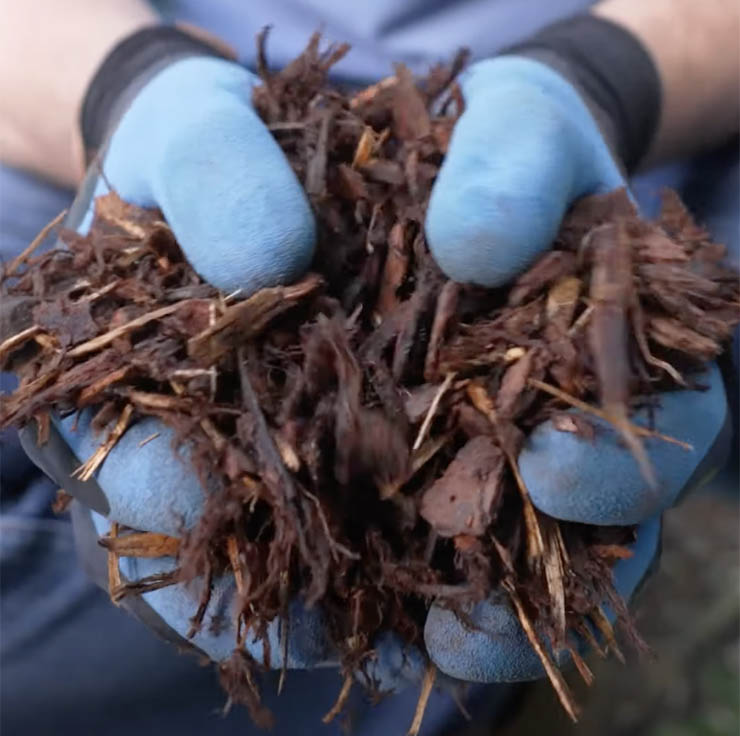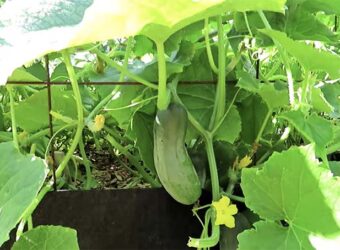Research has shown that mulching helps plant health. Each type of mulch has different uses. This guide tells you all about pine bark mulch.
What is Pine Bark Mulch?
When pine trees are cut for lumber, the branches and bark are removed before the tree is cut into boards. Pine bark mulch is the bark removed from the pine trees. It can be large chunks of bark, called nuggets, or shredded bark. Some pine bark mulch has bits of tree attached, but most are just the bark.
Pros and Cons of Pine Bark Mulch
Here are the good and the bad of using pine bark mulch.
Pros
- Reduces evaporation and helps hold in soil moisture. Mulch protects the soil from wind which wicks the moisture out of the soil. It also protects the soil from the sun that dries the soil.
- It controls weeds in the garden and around trees and shrubs. Three inches of mulch keeps weeds from growing around trees, shrubs, and ornamental plants.
- Regulate soil temperature to keep it warmer in winter and cooler in the summer. The mulch insulates the soil, so it does not change temperature as much as unmulched soil.
- Prevents soil crusting, which helps improve water absorption. Soil crust hardens, and water tends to run off instead of absorbing into the soil.
- Protects soil against erosion. Wind cannot blow the soil away, and water is less likely to wash the soil away, forming gullies in your soil.
- Adds organic matter to the soil to improve the soil structure, soil aeration, water percolation, and water retention. Generally, an inch of pine bark decomposes each year and adds organic matter to the soil.
- Reduces soil splashing, which protects plants from soil-borne diseases. Many soil-borne diseases start when soil splashes onto the plant during a rain. Mulch keeps this from happening and reduces the incidence of disease in your plants.
- Protects ripening vegetables from contact with the soil and reduces rotting and bad spots on the fruit. Mulch also helps keep rolly pollies and other ground insects from eating your fruit.
- Protects the trunks of trees and shrubs from lawn equipment, which can kill them. String edgers can girdle a tree trunk and kill the tree. Wounds allow opportunistic infections to enter the plant. Mulching around the tree or shrub keeps you from having to use string edgers near them.
- Increases the beauty of the garden and landscape. A fresh inch of pine bark mulch each spring brightens the landscape beds and areas around trees and shrubs.
- It is a renewable resource. Pine bark comes from trees grown to be used as lumber, so is readily available.
- Lasts at least two years in the garden. A three-inch layer of mulch should last approximately three years in the garden, even if you do not add more each year.
Cons
- Can acidify soil if used over several years. Pine bark is acidic, and while that is good for blueberries and strawberries, plants that like alkaline soil may struggle when the pine bark acidifies the soil. This happens slowly over several years.
- It can be difficult to remove. Because the mulch decomposes an inch a year, it can be hard to get it out of the garden if you change your mind about using it.
- Snails and slugs are more frequent when pine bark mulch is used than over unmulched soil. They can be controlled with traps and iron slug bait.
Pine Bark Mulch Nuggets Versus Shredded Bark
Pine bark nuggets are larger pieces of pine bark. Some large nuggets do not work well. Smaller nuggets can be as fine as shredded bark. Shredded bark does not leave as many gaps when spread as the larger pine bark nuggets do. Gaps allow soil moisture to escape and weed seeds to grow. I recommend using shredded pine bark or very small nuggets as mulch.
When Do You Use Pine Bark Mulch?
Pine bark mulch is best used around acid-loving plants or for paths.
What is the Best Time of Year to Apply Pine Bark Mulch?
Any time of the year that you plant a new tree, shrub, or ornamental plant, you should spread three inches of mulch around the plant. This helps keep the root ball moist until the roots get established.
In the spring, when the soil warms up, apply one inch of new mulch over the old pine bark mulch to keep the depth at three inches deep. Not only does this replace the mulch that has decomposed over the last year, but the new mulch looks nice and brightens the landscape.
How Do You Apply Pine Bark Mulch to Your Garden?
Pine bark mulch is used in different ways in different parts of the garden. In all uses, the pine bark mulch should not touch the plant. Leave a gap of three inches between a tree trunk or shrub trunk and mulch, and leave a gap of one inch between smaller stems and mulch. If the mulch touches the trunk or stem, it can cause a rotten spot that can kill the plant.
Vegetable Gardens
I would not use pine bark mulch around the vegetable garden. Almost all vegetables like alkaline soil, including common crops like tomatoes and cucumbers, and pine bark mulch can make the soil too acidic over time. I would use straw or hardwood mulch instead.
Read here for more details on mulching vegetable gardens.
Flower Beds
Pine bark mulch is excellent around rhodendrons, azaleas, and other acid-loving plants. Roses also do well with pine bark mulch because they like slightly acidic soil. I would not use it around other perennials because it will make the soil too acidic. Hardwood mulch is better. Wait to mulch areas you have seeded with annuals until the seedlings are up and at least four inches tall.
Read here for more details on mulching flower beds.
Fruit Trees
Most fruit trees need alkaline soil to grow well. Pine bark mulch is not helpful around them because it is too acidic. I would use hardwood mulch around a few fruit trees or a living mulch of clover in an orchard. If you use hardwood mulch, make a donut around the tree starting three inches from the trunk and extending to the drip line. The mulch should be three inches deep.
Berries
Blueberries and strawberries love acidic soil. Pine bark mulch is ideal for mulching around them. Blackberries need alkaline soil, so I would use hardwood mulch around them. Extend the mulch in a circle around them from three inches from the trunk to the edge of the drip line and three inches deep.
Ornamental Trees and Shrubs
Acid-loving ornamentals like dogwoods will benefit from pine bark mulch. Alkaline-loving trees and shrubs would do better with hardwood mulch.
Landscape Uses
Shredded pine bark makes nice paths through the garden. It is not expensive, so can be used cheaper than gravel or rock.
Where Do I Buy Pine Bark Mulch?
Pine bark mulch is widely available. You can find it from Home Depot, Lowe’s, Callaway’s, and most nurseries. Many bulk soil and mulch suppliers sell it, as well. You can order it online from the big box stores or Amazon, but it will be more expensive than at your local supplier. It is quite bulky, and the shipping adds a lot to the cost.
Some Good Pine Bark Mulch Options
Timberline is a good manufacturer of both pine nuggets and shredded pine bark mulch. They source the material from lumber mills and other places that process trees into products. Timberline is distributed mostly in the Eastern and Mid-Western United States and can be found at Lowe’s, Ace Hardware, and other places.
Permagreen Organics produces pine bark mulch and pine bark nuggets. They are based in Colorado and are distributed by Lowe’s. They also obtain their bark from places processing pine trees into other products like lumber.
Frequently Asked Questions
Is pine bark mulch safe for dogs?
Yes, any wood-based mulch is safe for dogs.
Does pine bark mulch attract termites?
Studies have shown that pine bark mulch does not attract termites. However, it can be used as a bridge between the ground and a building if the termites are already present. It is a good idea to leave a foot gap between mulch and any building.
How do I get rid of the sour pine bark mulch smell?
Spread the mulch out to no more than four inches deep and water it. Let the mulch dry in the sun for several days. This should remove the sour smell. Pine bark mulch rarely develops a sour smell unless it is in piles more than four feet tall. If you pile it higher than that, you will need to turn the pile periodically to prevent the sour smell or from it composting too hot and catching fire.
In conclusion, pine bark mulch comes in nuggets or shredded. I prefer shredded, but small nuggets are effective, too. Pine bark mulch is acidic and will acidify your soil over several years. It is best used around acid-loving plants such as azaleas, blueberries, and dogwoods.






